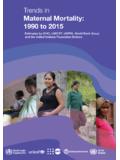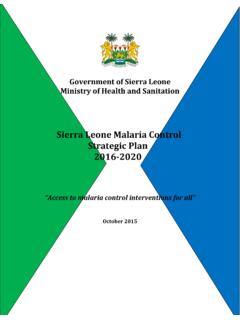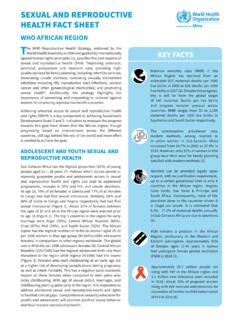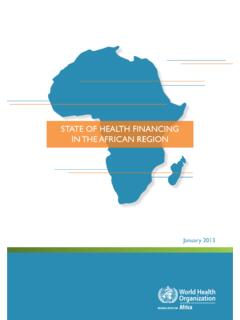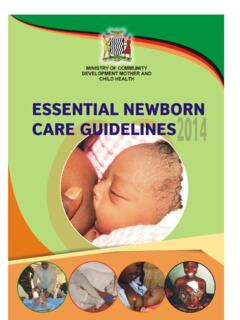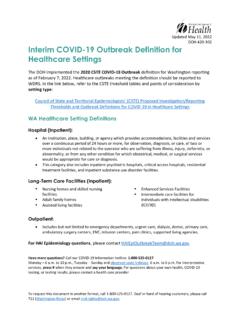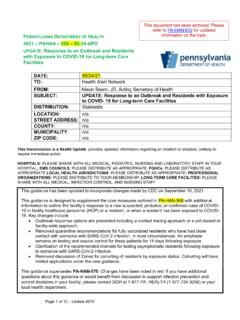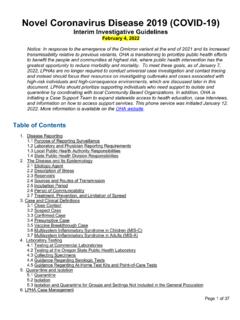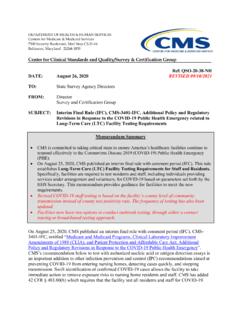Transcription of ISEASE SURVEILLANCE AND RESPONSE PROGRAMME …
1 INTEGRATED DISEASE SURVEILLANCE AND RESPONSE IN THE AFRICAN REGION. A GUIDE FOR ESTABLISHING COMMUNITY BASED SURVEILLANCE . DISEASE SURVEILLANCE AND RESPONSE PROGRAMME AREA. DISEASE PREVENTION AND CONTROL CLUSTER. August 2014. INTEGRATED DISEASE SURVEILLANCE AND RESPONSE IN THE AFRICAN REGION. A GUIDE FOR ESTABLISHING COMMUNITY BASED SURVEILLANCE . DISEASE SURVEILLANCE AND RESPONSE PROGRAMME AREA. DISEASE PREVENTION AND CONTROL CLUSTER. August 2014. WORLD HEALTH ORGANIZATION. Regional Office for Africa Brazzaville 2014. WHO/AFRO Library Cataloguing-in-Publication Data Integrated disease SURVEILLANCE and RESPONSE in the African Region: a guide for establishing community based SURVEILLANCE 1.
2 Epidemiological Monitoring 2. Communicable disease control organization and administration 3. Community Health Planning 4. Disease notification 5. Guideline 6. Data Collection I. World Health Organization. Regional Office for Africa ISBN: 978 929 023 259 9 (NLM classification: WA 105). WHO Regional Office for Africa, 2014. Publications of the World Health Organization enjoy copyright protection in accordance with the provisions of Protocol 2 of the Universal Copyright Convention. All rights reserved. Copies of this publication may be obtained from the Library, WHO Regional Office for Africa, Box 6, Brazzaville, Republic of Congo (Tel: +47 241 39100; +242 06 5081114; Fax: +47 241 39501.)
3 E-mail: Requests for permission to reproduce or translate this publication whether for sale or for non-commercial distribution should be sent to the same address. The designations employed and the presentation of the material in this publication do not imply the expression of any opinion whatsoever on the part of the World Health Organization concerning the legal status of any country, territory, city or area or of its authorities, or concerning the delimitation of its frontiers or boundaries. Dotted lines on maps represent approximate border lines for which there may not yet be full agreement.
4 The mention of specific companies or of certain manufacturers' products does not imply that they are endorsed or recommended by the World Health Organization in preference to others of a similar nature that are not mentioned. Errors and omissions excepted, the names of proprietary products are distinguished by initial capital letters. All reasonable precautions have been taken by the World Health Organization to verify the information contained in this publication. However, the published material is being distributed without warranty of any kind, either express or implied.
5 The responsibility for the interpretation and use of the material lies with the reader. On no account shall the World Health Organization or its Regional Office for Africa be liable for damages arising from its use. Printed in the Republic of Congo CONTENTS. Page ACKNOWLEDGEMENTS .. iv 1. 1. 2. SCOPE AND OBJECTIVE OF THE GUIDE .. 1. 3. KEY CONCEPTS AND PRIORITY CONDITIONS FOR CBS .. 2. What is SURVEILLANCE ? .. 2. What is Community Based SURVEILLANCE .. 3. Integrated Disease SURVEILLANCE .. 3. Priority diseases for CBS .. 3. 4. KEY ELEMENTS FOR COMMUNITY BASED 3. CBS Tasks.
6 3. Formalized CBS 4. Community representatives that can be members of CBS team .. 4. Establishing a CBS .. 4. CBS Supervision .. 5. 5. SOURCES FOR COMMUNITY BASED SURVEILLANCE .. 5. 6. STEPS FOR ESTABLISHING CBS .. 6. 7. TRAINING PACKAGE FOR CBS FOCAL POINTS .. 6. REFERENCES .. 8. ANNEXES. 1. Preparing to conduct community SURVEILLANCE and RESPONSE .. 9. 2. Key simplified signs and symptoms for case definitions for use at community level .. 10. 3. IDSR core functions and activities by health system 11. iii ACKNOWLEDGEMENT. This document was developed by the WHO Regional Office for Africa.
7 The following professionals participated actively in the various stages of developing this guide: Mr Eugene Tebogo Mahlehla, WHO Country Office, South Africa Dr Ali Ahmed Yahaya: WHO Regional Office for Africa Dr Francis Kasolo, WHO Regional Office for Africa Dr Peter Gaturuku, WHO Regional Office for Africa Mme Linda Muzenda, WHO Regional Office for Africa Mr Peter Malekele Phori, WHO Regional Office for Africa Dr Fernando Da Silveira, WCO Intercountry Support Team, Central Africa Dr Sally-Ann Ohene, WHO Country Office, Ghana Dr Joyce Kerubo Onsongo, WHO Country Office, Kenya Dr Lincoln Charimari, WHO Country Office, Zimbabwe Dr Adama Berthe, WCO Intercountry Support Team, West Africa Mme Volahanta Malala Ranarison, WHO Country Office.
8 Madagascar Mme Celia Kaunatjike, WHO Country Office, Namibia Benjamin Sensasi, WHO Country Office, Uganda Mme Maria Da Gloria Moreira, WHO Country Office, Mozambique Mme Nora Mweemba, WHO Country Office, Zambia Dr Helen Perry, US CDC, Atlanta, USA. Dr David Bull, US CDC, Atlanta, USA. iv 1. INTRODUCTION. Emerging and re-emerging events with a potential to cause disease outbreak remain a constant threat to global health security. In Africa, community volunteers are supporting initiatives and programmes like polio eradication, onchocerciasis, guinea worm eradication, trachoma control, integrated community case management, maternal and child health integrated PROGRAMME , and early warning and RESPONSE to public health emergencies among others.
9 In some communities structures are not functional or are still to be built to detect, prevent and respond to public health events, despite the fact that the first edition of the Integrated Diseases SURVEILLANCE (IDS) in the African Region advocated for countries to establish Community-based SURVEILLANCE (CBS). systems since 2001. Community representatives and health workers with instructions on how to recognise certain diseases or health conditions were to be used as contact persons in the community for the purpose of detecting and reporting suspected cases to the health facility.
10 In the first edition of IDS, tasks at community level included: (a) Notifying the nearest health facility of the occurrence of disease or health conditions selected for community-based SURVEILLANCE . (b) Supporting health workers during case or outbreak investigation, and contact tracing. (c) Using feedback from health workers to take action, including health education and coordination of community participation. The first edition has been extensively revised, and the second edition (2010) is now titled Integrated Disease SURVEILLANCE and RESPONSE (IDSR). While WHO has been assisting countries to develop and implement the second edition, this effort has had mixed progress.
